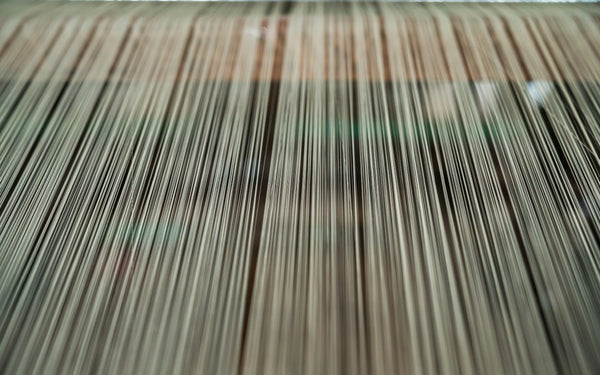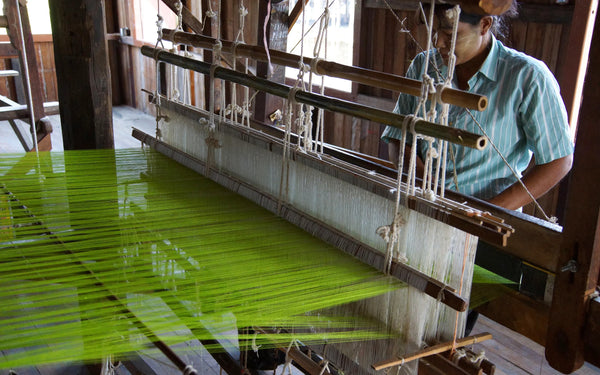Key Takeaways
silk naturally has a white or ivory color. Its color varies slightly depending on the type of silk (wild, mulberry, tussah etc.) and the species of silkworm from which it comes. dyeing allows you to obtain all colors.
The French brand The Oversized Hoodie® 🇫🇷 is famous for its textile expertise, particularly its collection of high-end, 100% natural mulberry silk products certified Oeko-Tex® Standard 100.
Free from toxic and chemical substances, and ecological, the collections silk pillowcase, silk night maskand silk sheets stand out for their incomparable softness and excellent value for money, providing an unrivaled feeling of comfort.
The origin of silk
silk comes from the filamentous secretion of the cocoon woven by the silkworm (Bombyx mori) to metamorphose into butterfly. This extremely fine, strong and shiny continuous thread is then unwinded to obtain a thread of silk used in textile making .
The first traces of sericulture (breeding of the silkworm) and silk weaving date back to China ancient, almost 5000 years ago. The Silk Road testifies to the importance of this trade along the Eastern Roman Empire and in Asia.
Today, China remains the world's leading producer of silk, followed by India, Brazil, Uzbekistan and Vietnam.
The natural color of silk
The silk produced by the silkworm naturally has an immaculate white color, slightly ivory or cream. This color results from the composition of the secreted fiber: fibroin, a whitish protein.
The color of the silk may vary significantly depending on:
- The type of silkworm (more than 500 species recorded)
- The feeding of caterpillars (leaves of mulberry, oak, plum etc.)
- The plant species from which the leaf consumed comes
- The region and the climate of production
- The maturity of the cocoon during harvest
The color shades of silk depend on many factors such as the species of silkworm, its diet and production conditions. This variety of natural shades is what makes silk so charming and noble.
— Geoffrey, Founder of The Oversized Hoodie®
There are several types of silk with different natural shades:
- Wild silk: golden brown
- Purple silk: purplish reflections
- Yellow silk: yellowish tint
However, the vast majority of silk produced worldwide is white or ivory.
| Silk Type | Natural Color | Origin | Usage |
|---|---|---|---|
| Raw silk / raw silk | Golden yellow | Silkworm cocoon | Textile manufacturing before treatment |
| Mulberry silk | White or ivory | Silkworm (Bombyx mori) | High-end textiles |
| Wild silk | Golden brown | Silkworms raised outdoors | Textiles with changing reflections |
| Silk satin | Bright white | Twisted silk threads | Shiny, close-to-the-touch fabric |
| Silk crepe | Off-white | Textured silk fiber | Vapour fabric with grained texture |
| Chiffon | White or ecru | Very fine silk fiber | Light and airy fabric |
| Tussah silk | Brunette | Oak leaves | Textile with characteristic shade |
| Pongee silk | Slightly yellowish ivory | Natural silk fiber | Soft and light textile |
| Shantung silk | White or ecru | Natural silk fiber | Textured wild silk fabric |
| Habotai silk | Golden brown | Wild silk | Light and soft textile |
| Silk organza | White | Very light silk fiber | Transparent and rigid fabric |
Dyeing of silk
As silk is naturally white, dyeing processes are used to obtain a wide range of bright and vibrant colors.
Dyed silk can be used for making clothing, textile accessories (scarves, ties), household linens (sheets, curtains), as well as in embroidery, silk painting, etc.
Natural dyes (madder, pastel, indigo) have long been used since Antiquity, before the arrival of synthetic chemical dyes in the 19th century.
The dyeing of silk uses complex techniques to preserve the shine and strength of the fiber.

Also read: How to recognize real natural silk ?
The colors of natural silks according to their type
Raw silk
raw silk or raw silk designates the thread of silk directly from the cocoon before bleaching or dye. Its golden yellow shade is due to the natural secretions of the silkworm.
Mulberry silk
The mulberry silk, from the silkworm (Bombyx mori) fed on mulberry leaves, has a white or ivory coloring. It is the most common.
Wild silk
Wild silk comes from silkworms raised outdoors. Its golden brown color results from their diversified diet.
Silk satin
silk satin is a fabric shiny with a close feel produced from threads of silk twisted. Its natural color is bright white.
Silk crepe
The silk crepe is a vaporous fabric with a grained texture. Its original color is off-white.
Silk chiffon
The silk muslin, very fine and light, has a natural color white or ecru.
Tussah silk
Tussah silk is produced by worms feeding on oak leaves. It has a characteristic brown shade.
Pongé silk
ponge silk has a ivory slightly yellowish tint.
Shantung silk
The silk shantung has a natural white or ecru color.
Habotai silk
The habotai is a wild silk of golden brown.
Silk organza
silk organza is a very light and transparent fabric whose natural color is white.

Recently, a customer contacted us after receiving one of our pillowcases in silk, surprised by its slightly yellowish tint. Having always associated silk with a pristine white color, she feared that it was not quality silk.
After explaining to him that our silk comes from worms fed on mulberry leaves, giving the fabric these pretty reflections ivory, the client was reassured. She realized how much the natural color of silk can vary depending on many factors such as the diet of the caterpillars.
This anecdote illustrates how little is known about the actual color of silk. Contrary to popular belief, it is not always pure white!
Also read: What is the best silk in the world ?
The colors of synthetic silks
There are also synthetic silks produced from chemical fibers. The most common are:
Polyester
polyester is a synthetic fabric that is not very breathable, generally colored white or black.
Viscose
viscose is a bleached vegetable fiber whose original color is ivory.
Nylon
nylon is a synthetic silk from petrochemicals, colored white or black.
Radiates
rayon is a semi-synthetic cellulosic fabric with a natural white color.
What is the rarest color of silk ?
The rarest color of silk is blue, because it is difficult to obtain by natural dyeing.
yellow is also a rare color for silk, reserved for certain types of silk such as wild silk or pongee silk.
How to identify the natural color of silk ?
To identify the original color of a silk fabric, several methods:
- Observe the edges or back of the fabric, generally undyed
- Perform a drop test on an inconspicuous area: the silk dye bleeds, unlike the natural silk
- Have the fabric analyzed by a professional who will determine its origin
- Refer to the label of the garment which must mention the type and composition of the fabric

What is the best color of silk for a wedding ?
The ideal silk color for a wedding dress is often immaculate white, which symbolizes purity.
However, more and more future brides are daring to use color, such as pale pink, sky blue, almond green or even gold and silver for an evening dress.
The dye allows you to obtain the exact shade to match the wedding theme.
What is the difference between white silk and ivory silk ?
The white silk is a pure white of great luminosity.
The ivory silk has reflections slightly yellowish or cream, while remaining very light.
These two colors are suitable for a wedding dress, the ivory silk being however softer and discreet.
The manufacture of silk
The production of silk includes several stages:
- The rearing of silkworms and the production of cocoons
- The sorting and the storage of the cocoons
- The retting to weaken the cocoon
- The unwinding to extract the continuous wire
- The milling and the twisting of the thread of silk
- The weaving of the thread to obtain the fabric
- The possible dye to color the silk
This meticulous production, often artisanal, requires specific know-how passed down for generations.

Natural silk: an animal fiber
silk is the only textile made from an animal fiber, produced by the silkworm to build its cocoon.
How is it made ?
The silkworm secretes long filaments of fibroin which it coils into a spiral to protect itself during its pupation, forming a cocoon having the appearance of a small egg oval.
Once the butterfly hatches, the cocoon is immersed in hot water to soften the sericin, a natural glue .We then obtain a continuous thread of silk.
Silk has a unique texture that distinguishes it from all other textile fibers. Smooth, shiny and soft, it provides a pleasant sensation to the touch.
— Geoffrey, Founder of The Oversized Hoodie®
Where does silk come from ?
Historically, silk was only produced in China, the cradle of sericulture.
The manufacturing secret was jealously guarded for centuries before the silkworm technique spread along trade routes to Europe and America.
Today, China remains the world's leading producer of silk.
How to recognize real silk ?
To ensure the quality of a silk fabric, several criteria:
- Hand feel: soft, smooth, shiny, slippery
- Pulled thread: central rib visible
- flame test: characteristic odor of burnt hair
- Creasing: creases but does not crease
These properties help differentiate real silk from cheap imitations.

How to maintain natural silk ?
To preserve the beauty and qualities of a clothing or silk fabric, it is recommended to:
- Hand wash in cold water, with silk shampoo
- Use a soft brush to gently scrub stubborn stains
- Thoroughly rinse to remove any detergent residue
- Dry flat on a towel, in the shade, without wringing
- Iron if necessary on the reverse side with a lukewarm iron, without steam
- The store folded in a cotton cover, in a dry place
These simple precautions preserve the fineness of fibers and the moiré of silk fabrics, for a long-lasting silky feel.
Also read: How to wash silk ?
Conclusion
silk naturally has an immaculate white or ivory color depending on the species of silkworm from which it comes and its power supply.
Its shade can vary from golden yellow to brown including purplish reflections.
The dye makes it possible to obtain all the bright colors for the making of clothes and textile accessories in silk.
Precious and refined, silk remains a noble and natural material that should be pampered!
FAQ
How is silk made ?
The silk is secreted in the form of long filaments by the caterpillar of the silkworm, to build its protective cocoon. This continuous thread is then unwinded then woven.
How to tell if it's real silk ?
Several criteria make it possible to recognize real silk: soft and shiny feel, crumpling characteristic, ribbed thread, smell of burnt hair.
How to tell if a fabric is silk ?
In addition to the label of the garment, you can test with the flame or with the drop of water to verify that it is indeed of natural silk.
What is the most beautiful silk ?
The most prestigious silk is wild silk, with golden and changing reflections. duchess satin is also very popular for its finesse.
Synthetic silk: what material ?
synthetic bristles are made from polyester, viscose, nylon or rayon. They imitate natural silk.
Synthetic or natural silk ?
Between synthetic or natural silk, natural silk is a animal fiber noble, strong and breathable . synthetic silk is a cheap but less comfortable imitation.
Where to buy real silk ?
You can find real silk in luxury boutiques, among certain designers, in specialized haberdashery or on e-commerce sites dedicated to noble fabrics.
The The Oversized Hoodie brand is recognized for its high-quality 100% mulberry silk products such as the silk pillowcase or the silk sleep mask. Designed from natural silk Oeko-Tex certified, they combine comfort, softness and refinement.
Sources
[1] "The secrets of silk", Etoffe.com
Updated February 20, 2024






